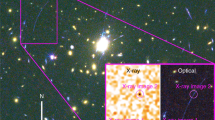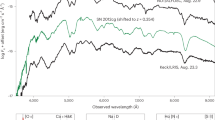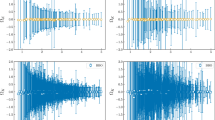Abstract
When a galaxy acts as a gravitational lens it behaves more like a raindrop deflecting sunlight than like a true lens. The images formed by a galaxy exist as directions of incidence of rays on the observer and the best a galaxy can do is to generate complex surfaces called caustics1–4. Here we point out that the caustic surfaces of galactic lenses are powerful telescopes, with point-source intensifications varying with frequency from 105 for radio waves to 108 for X rays. The diffraction limit to the angular resolution varies from 10–11 to 10–17 arcs from radio waves to X rays and exceeds the resolution of man-made telescopes by many orders of magnitude. The signature of a point source crossing the caustic is a burst of radiation modulated in time by a characteristic diffraction pattern. The microcaustic surfaces generated by stars in the lensing galaxy are also powerful telescopes that yield large intensifications of small sources crossing the microcaustic. Decaying cosmic strings could be an important source of cosmic rays with energies above 1010 GeV.
This is a preview of subscription content, access via your institution
Access options
Subscribe to this journal
Receive 51 print issues and online access
$199.00 per year
only $3.90 per issue
Buy this article
- Purchase on Springer Link
- Instant access to full article PDF
Prices may be subject to local taxes which are calculated during checkout
Similar content being viewed by others
References
1. Bourassa, R. R. & Kantowski R. Astrophys. J. 195, 13-21 (1975). 2. Young, P., Gunn, J. E., Kristian, J., Oke, J. B. & Westphal, J. A. Astrophys. J. 241, 507-520 (1980). 3. Ohanian, H. C. Astrophys. J. 271, 551-555 (1983). 4. Blandford, R. & Narayan, R. Astrophys. J. 310, 568-582 (1986). 5. Benson, J. R. & Cooke, J. H. Astrophys. J. 227, 360-363 (1979). 6. Landau, L. D. & Lifshitz, E. M. The Classical Theory of Fields (Pergamon, Oxford, 1975). 7. Ingel, L. Kp. & Rubakha, N. R. Astr. Zh. 52, 1049-1054 (1975); Soviet Astr. 19, 633-636 (1976). 8. Bontz, R. J. and Haugan, M. P. Astrophys. Space Sci. 78, 199-210 (1981). 9. Abramowitz, M. & Stegun, I. A. Handbook of Mathematical Functions, (Dover, New York,1965). 10. Bartel, N., Herring, T. A., Ratner, M. L, Shapiro, I. I. & Corey, B. E. Nature 319, 733-738 (1986). 11.Berry, M. V. & Upstiii, C. Progress in Optics Vol. 18 (ed. Wolf, E.) 257-346 (North-Holland, Amsterdam, 1980). 12. Turner, E. L., Ostriker, J. P. & Gott, J. R. Ill Astrophys. J. 284, 1-22 (1984). 13. Tyson, J. A. Astrophys. J. 272, L41-L44 (1983). 14. Schmidt, M. & Green, R. F. Astrophys. J. 269, 352-374 (1985). 15. Lynden-Bell, D. Phys. Scripta 17, 185-191 (1978). 16. Trimble, V. & Woltjer, L. Science 234, 155-161 (1986). 17. Chang, K. & Refsdal, S. Nature 282, 561-564 (1979). 18. Chang, K. & Refsdal, S. Astr. Astrophys. 132, 168-178 (1984). 19. Young, P. Astrophys. J. 244, 756-767 (1981). 20. Gott, J. R. Ill, Astrophys. J. 243, 140-146 (1981). 21. Canizares, C. R. Nature 291, 620-624 (1981). 22. Kayser, R., Refsdal, S. & Stabell, R. Astr. Astrophys. 166, 36-52 (1986). 23. Paczynski, B. Astrophys. J. 301, 503-516 (1986). 24. Schneider, P. & Weiss, A. Astr. Astrophys. 171, 49-65 (1987). 25. Peacock, H. A. Proc. 24th Liege int. Astrophys. Coll. 86-104 (Institute for Astrophysics, University of Liege, 1983). 26. Bontz, R. J. Astrophys. J. 233, 402-410 (1979). 27. Dyer, C. C. & Roeder, R. C. Astrophys. J. 249, 290-296 (1981). 28. Schneider, P. & Schmidt-Burgk, J. Astr. Astrophys. 148, 369-378 (1985). 29. Deguchi, S. & Watson, W. D. Astrophys. J. 307, 30-37 (1986). 30. Hogan, C. & Narayan, R. Mon. Not. R. astr. Soc. 211, 575-591 (1984). 31. Vilenkin, A. Phys. Rep. 121, 263-315 (1985). 32. Kibble, T. W. B. Nucl. Phys. B252, 227-244 (1985). 33. Hogan, C. J. & Rees, M. J. Nature 311, 109-114 (1984). 34. Watson, A. A. Q. Jl R. astr. Soc. 21, 1-13 (1980).
Author information
Authors and Affiliations
Rights and permissions
About this article
Cite this article
McBreen, B., Metcalfe, L. A galactic gravitational lens as the ultimate astronomical telescope. Nature 330, 348–350 (1987). https://doi.org/10.1038/330348a0
Received:
Accepted:
Issue Date:
DOI: https://doi.org/10.1038/330348a0
This article is cited by
-
Microlensing and polarization
Astrophysics and Space Science (1996)
-
Gravitational radiation and gravitational lensing as a source of electromagnetic bursts
Nature (1988)
Comments
By submitting a comment you agree to abide by our Terms and Community Guidelines. If you find something abusive or that does not comply with our terms or guidelines please flag it as inappropriate.



